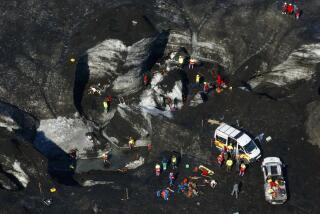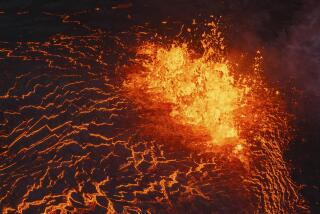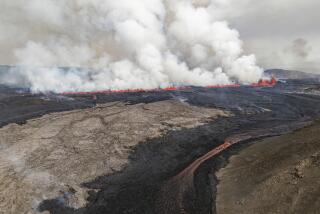1973 Eruption Nearly Destroyed Town : Icelandic Isle, Grown Larger by 20%, Builds on Its Volcanic Past
VESTMANNAEYJAR, Westmann Islands, Iceland — In the early hours of Jan. 23, 1973, a mile-long fissure opened up on Iceland’s Heimaey Island, and a new volcano was born in a spectacular fountain of fire. The eruption sent islanders fleeing in fishing boats and destroyed a large part of the town of Vestmannaeyjar. Here is another look at the volcanic isle 16 years later.
Sixteen years after it roared to life, the 725-foot Eldfell volcano looks down almost benignly these days on the town it came close to destroying.
The only reminder of its fiery birth Jan. 23, 1973, is a light dusting of black ash that settles over this picturesque fishing port whenever the east wind blows.
Otherwise, few of the 4,800 islanders take much notice of Eldfell’s belches and occasional wisps of steam.
And nobody seems worried about another eruption.
Smoking ‘More Dangerous’
“It’s more dangerous to smoke than to live here,” said Pall Zophoniasson, a former mayor of Vestmannaeyjar, the town on Heimaey, one of the Westmann Islands, 10 miles off Iceland’s south coast.
In fact, the volcano has brought benefits to the 4,800 islands: heat for their homes and businesses from the lava, more building materials than they need and more living space--the island is bigger.
Heimaey is the largest of the 15 Westmann Islands and Vestmannaeyjar was Iceland’s chief fishing port before the volcano was born. Vestmannaeyjar has regained its premier position, having become so prosperous that other Icelanders joke about its residents owning the largest number of cars per capita even though they can easily walk around town.
Nobody died in the eruption in 1973, but more than 400 homes and businesses were destroyed. The volcano spat out lava for five months, hence the name Eldfell--Fire Mountain.
A Longer Runway
The lava made Heimaey 20% bigger, at 5.4 square miles. The harbor is more sheltered than before and the town is better protected from the wind. Much of what Eldfell brought forth went toward lengthening the airport’s runway and building 400 new homes.
The islanders also have harnessed Eldfell’s 2,000-degree heat.
“This is the first and only system in the whole world which uses warmth from lava to heat a town,” Zophoniasson said.
Before the eruption, Heimaey had a shortage of construction material. Now, Zophoniasson said, “we have more than we can use for the next thousand years.”
He was talking about lava rocks, which he said also can be used to make asphalt.
The new land is an eerie gray moonscape, incongruously attached to a thriving, verdant town with brightly painted houses.
Several residential streets disappear into a solid wall of lava and a few crushed houses, embedded at the edge of the lava, have been preserved for posterity.
Second to Hawaii
Iceland averages an eruption about every five years, making it second only to Hawaii in volcanic activity. On Nov. 14, 1963, an undersea eruption about 13 miles southwest of Heimaey spawned an entire new island, called Surtsey, which was declared a natural preserve so scientists can study how life inhabits a new land.
Heimaey’s existing volcano, Helgafell, had been dormant for 5,000 years, so Eldfell’s sudden birth came as a shock.
A 5,300-foot fissure on the Heimaey’s east side erupted without warning that wintry morning 16 years ago, shooting fountains of fiery lava 500 feet into the pre-dawn sky.
Those who weren’t awakened by the rumbles were roused by fire alarms and police sirens. Island officials consulted with Reykjavik, Iceland’s capital, and decided to evacuate the 5,300 people living here at the time to the Icelandic mainland.
Fortunately, the islands’ entire fishing fleet was in port along with other boats sheltering from a gale the previous day. They became an evacuation flotilla.
Absence of 8 Months
Eva Anderson, pregnant at the time, grabbed the things that were closest and headed for the harbor along with most of the rest of the townspeople, thinking she would be gone for just a few days. She returned eight months later.
Brynjar Kristjansson, who is studying hotel management, said: “I was only 5 years old and I remember I said to my mother this was fireworks. I thought they were celebrating the new year.”
Zophoniasson estimates that up to one-third of the evacuees never returned.
“Most of them lost their houses--that was one of the biggest reasons they didn’t come home again,” he said.
After the evacuees had gone, Zophoniasson and about 100 islanders stayed to try to save the town.
They shipped furniture and possessions to the mainland. They put iron plates on windows facing the volcano to prevent lava fires. They removed tons of ash from roofs to prevent collapse.
Work crews built barriers and pumped sea water onto the lava to cool it, but succeeded only partly in halting its flow, which eventually covered farms, meadows and the northeastern part of town.
A Threat to Harbor
Meanwhile, a massive and separate pumping operation was mounted, helped by powerful pumps flown in from the United States, to cool the torrent of lava that was pouring into the sea and threatening to block the harbor.
Every hour for three months, about 3,800 tons of water was poured onto the lava’s leading edge in what geologist Thorleifur Einarsson called the largest lava-cooling operation ever undertaken.
It worked.
“Before, the harbor was open to the east wind, which is the worst weather condition here,” said the current mayor, Arnaldur Bjarnason. “But now, the harbor is guarded by rocks on the north side and new lava on the south side.”
Workers cleared 2 million cubic feet of volcanic ash from the town.
“We still have a lot of ash from the lava flow,” said Fridrik Jesson, 83, who runs the Aquarium and Museum of Natural History in Vestmannaeyjar. “If the east wind is blowing, we still have to clean up, but only a little now.”
More to Read
Sign up for Essential California
The most important California stories and recommendations in your inbox every morning.
You may occasionally receive promotional content from the Los Angeles Times.










